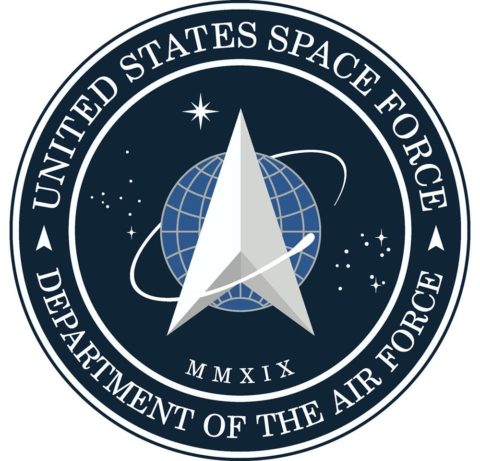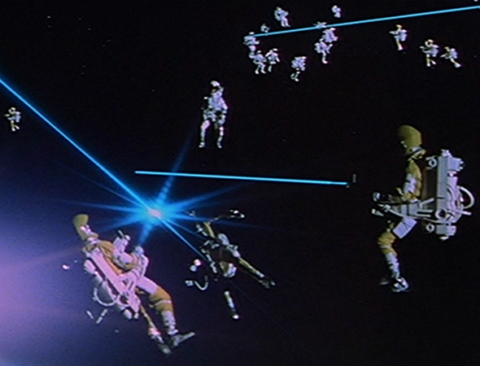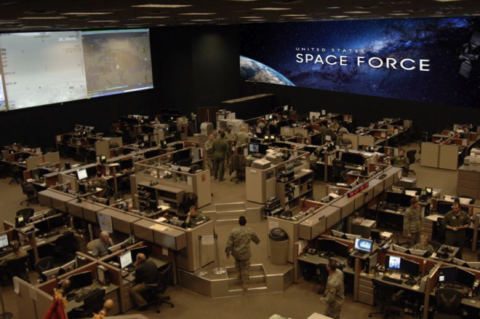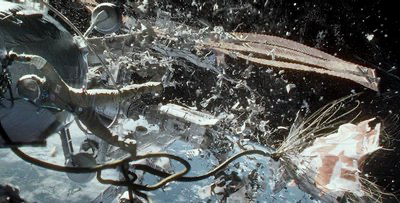This is Part IV of “Tucson after the Coronavirus“… but it’s not really triggered by COVID-19. The idea of bringing substantial Space Force operations to Tucson has been a hobbyhorse of mine for a couple of years now. This series of posts is engaging in a little soul-searching about how Tucson will recover from the pandemic, and we’ve already looked at academia and manufacturing. What about the other pillar of our community, the military?
I wrote an earlier version of this for the Arizona Commerce Authority in late 2018, and it’s probably worth sharing with a wider audience.
First, a little background:

The idea of a separate military service for space is not new, and actually dates back decades, including formal consideration by Presidents George W. Bush, Barack Obama, and Donald Trump. In 2017 and 2018, key members of the House Armed Services Committee (HASC) advocated for a Space Corps as part of the Air Force, analogous to the Marine Corps within the Department of the Navy; enabling language for that approach was included in the House version of the National Defense Authorization Act of 2018, but did not survive conference committee with the Senate. That approach (replacing the name “Space Corps” with “Space Force”) is essentially what is now being implemented.
In June 2018, President Trump instructed the Chairman of the Joint Chiefs of Staff to follow the House recommendation and establish a standalone “U.S. Space Force.” In February 2019, the President signed Space Policy Directive 4, which formalized the steps to standing up a Space Force reporting to the U.S. Air Force. And on 20 December 2019, President Trump signed the 2020 National Defense Authorization Act, which established the U.S. Space Force as the sixth armed service branch.
About 16,000 Air Force active duty and civilian personnel are to be assigned to the Space Force while the branch is gradually integrated into the U.S. Armed Forces ecosystem. (Compare that to the U.S. Coast Guard, with 41,000 active duty personnel and a budget of $10 billion/year.)
This is consistent with the 2018 National Strategy for Space, which outlines four pillars for a unified approach to secure U.S. space leadership:
- Transform to more resilient space architecture,
- Strengthen deterrence and warfighting options,
- Improve foundational capabilities, structure, and processes, and
- Foster conducive domestic and international environments for space development.
And, contrary to Steve Carell’s bombast in the new Netflix “Space Force” series, the real Space Force has nothing whatsoever to do with “Boots on the Moon!” That’s NASA’s job, supported by the private sector (and that’s a different blog post).
An August 2018 report commissioned by Vice President Pence (in his role as Chairman of the National Space Council) has recommended four initial steps:
- Create a unified combatant command for space — United States Space Command — led by a four-star flag officer.
- Create a Space Operations Force, an elite corps of “space warfighters” to support the U.S. Space Command.
- Create a joint Space Development Agency to ensure the Space Force has cutting-edge warfighting capabilities. It will focus on innovation, experimentation and forging the technologies of the future, breaking free of existing inefficient and duplicative bureaucracy.
- Create a new civilian position at DOD, an Assistant Secretary of Defense for Space, reporting to the Secretary of Defense, with responsibility and accountability for standing up and scaling up the U.S. Department of the Space Force.
The unified combatant command is now in place, and the other three steps are underway.
Space Force Mission

First, let’s talk about what is not the mission of the U.S. Space Force. Unlike this image from the astonishingly bad 007 film “Moonraker,” we aren’t going to see spacesuited troopers firing laser rifles and boarding hostile space stations anytime soon. Missions that involve launching USSF officers and enlisted personnel into orbit are hypothesized, but none are planned, authorized, or budgeted. Nor will the Space Force be focused on protecting the planet against alien invasion.
Instead, the USSF is responsible for organizing, training, and equipping forces for the following missions:
- space superiority;
- space domain awareness (military, civil, and commercial);
- offensive and defensive space control;
- command and control of space forces and satellite operations;
- space support to operations (e.g., satellite communications);
- space service support (e.g., spacelift and space range operations for military, civil, and commercial operators);
- space support to nuclear command, control, communications and nuclear detonation detection; and
- missile warning and space support to missile defense operations.
So, for the foreseeable future, all of the Space Force’s personnel will remain firmly on the ground. Most USSF officers will spend their day peering at computer screens… think “War Games,” not “Star Wars.”

Space Domain Awareness
It’s worth calling out one of those missions for a bit more clarity. The Pentagon defines “Space Domain Awareness” as the “identification, characterization and understanding of any factor, passive or active, associated with the space domain that could affect space operations and thereby impact the security, safety, economy or environment of our nation.”
In layman’s terms, that mostly means:
- What’s in orbit?
- Where did it come from?
- Where is it going?
- If left alone, could it impact any of our satellites or those of our allies?
- Is it able to maneuver to threaten any of our satellites?
“It” may be a functioning satellite or other spacecraft… or a derelict, unable to maneuver… or a piece of debris left over from an earlier mission… or even a natural space rock that’s wandering through Earth’s orbit.
Keep in mind that there’s a lot of derelicts and debris in orbit… tens of thousands of pieces are being tracked by radar and telescopes, and there are hundreds of thousands more pieces too small to observe from the Earth. There’s currently not a good way to deal with this debris. Space is big, but certain orbits are popular, and accidental collisions have already occurred. The problem is going to get much, much worse as the currently planned “megaconstellations” are launched over the next few years.
(For scale: all told, since the Soviets orbited Sputnik in 1957, there are about 5,000 surviving satellites in Earth orbit…. 2,000 functioning, and 3,000 derelict. SpaceX alone has FCC licenses to launch 12,000 satellites, and has applied for permission to launch 30,000 more!)
The U.S. Space Force will be responsible for tracking all of these objects, and predicting potential collisions. Note that a collision not only destroys the target satellite, but spins off thousands of new pieces of debris in their own individual orbits, making the problem much worse. The Sandra Bullock movie “Gravity” got a lot of the details wrong, but the fundamental risk is quite real.

Arizona’s Assets
Arizona has a strong presence in military aerospace, and can offer an impressive inventory of space-related assets:
- Historically dark skies, which lend themselves to ground-based telescopes for observation of artificial satellites, crewed space vehicles and stations, near-Earth astronomical objects, and other items of interest to the military. The University of Arizona and the U.S. Naval Observatory in Flagstaff already operate multiple telescopes around the state which deliver critical observations for incorporation into Space Domain Awareness (SDA) analyses. This will be a core mission for the U.S. Space Force.
- The Space Situational Awareness group at the University of Arizona, which has recently won nearly $7 million in awards from the USAF, DARPA, and Lockheed-Martin, is one of the strongest academic SDA departments in the world. We have approximately 25 graduate students engaged in SDA across multiple departments, including aerospace and mechanical engineering, systems and industrial engineering, planetary sciences, astronomy, and optical sciences. These students represent the next generation of leadership for the U.S. Space Force.
- Exceptionally fine weather, allowing outdoor testing of rocket engines, lasers, radars, and other space-related hardware more than 300 days per year.
- A consistent Top Five ranking among aerospace manufacturing states, with over 1200 aerospace manufacturers. Raytheon, Honeywell, General Dynamics, Boeing, and Northrop Grumman all have major operations in Arizona. In 2018, Northrop’s operation in Chandler won an $800 million USAF contract to build a new heavy-lift rocket.
- A well-educated aerospace workforce comprising 55,000 people and a payroll of over $5 billion annually.
- UA’s Lunar and Planetary Lab, with a record of successful space mission management for NASA that includes the Mars Phoenix lander and the current $1 billion OSIRIS-REx mission, as well as the HI-RISE camera (basically, a surveillance satellite orbiting Mars).
- UA’s top-ranked College of Optical Sciences, whose roots trace back to classified surveillance satellites in the 1960s and 1970s. We award nearly 100 undergraduate and graduate degrees per year, delivering highly-skilled scientists and engineers who will be critical to executing the Space Force mission.
- A growing community of space-related startups, including WorldView, FreeFall Aerospace, and Lunasonde (all of whom have potential military applications) as well as older companies like Rincon Research (classified software and hardware) and Paragon (space life support). Many of these companies are connected through the Arizona Space Business Roundtable, which I organized in 2017.
- Davis-Monthan AFB, which won the 2018 Commander-in-Chief’s Installation Excellence Award as the “best base in the Air Force” (for the second time in six years). Among other missions, Davis-Monthan is the headquarters of the 12th Air Force, which includes a sophisticated Air and Space Operations Center for command and control of air activity in the USSOUTHCOM area (Central America, Latin America, and the Caribbean).
- The Goldwater Range, approximately the size of Connecticut, with 57,000 cubic miles of military-controlled airspace. This is one of very few locations in the U.S. which can support short-notice orbital or suborbital launch without coordination with FAA civilian air traffic control.
Potential Roles for Tucson
Joint Base Davis-Monthan
Two Florida Air Force Bases are currently being renamed to “Patrick Space Force Base” and “Cape Canaveral Space Force Base.” It is unlikely that many more existing Air Force bases will be converted entirely to Space Force bases. It is more likely that Space Force operations will be located in existing Air Force bases, with facilities managed under both jurisdictions as Joint Bases (such as Joint Base Andrews, which supports both Navy and Air Force operations in suburban DC through Interservice Support Agreements).
I think “Joint Base Davis-Monthan” has a nice ring to it, doesn’t it?
Space Command HQ
In May 2019, the Pentagon announced that six locations were in the running for the Space Command HQ: Four in Colorado, and one each in California and Alabama. Many were surprised that Florida did not make the cut after a highly-visible campaign by the state’s governor and congressional delegation. A year later, the selection process has been re-opened, and all states are invited to compete for the HQ.
An earlier incarnation of the U.S. Space Command was active from 1985 to 2002, and was headquartered at Peterson AFB in Colorado. Peterson will be an obvious candidate for the new HQ. However, that will be a political decision, and Arizona could make a strong case for building a new “red state” HQ at Davis-Monthan. DM has the existing USSOUTHCOM operations center, a highly-trained workforce, friendly neighbors, and room to grow.
Space Operations Force HQ
It is unknown whether the “Space Operations Force” endorsed by Vice President Pence will be co-located with Space Command HQ or will be geographically separate. Politically, it is probably more attractive to split them among multiple states. If Florida is selected for HQ, we could argue for geographical balance between the East Coast and the West. In any case, it’s doubtful that Colorado would win both prizes, so Arizona gets two bites at the HQ apple.
“Space Operations” will look very similar today’s “Space Domain Awareness” plus new response capabilities by robotic satellites or quick-response missile launches. The University of Arizona is a world leader in SDA, and Raytheon Technologies could easily build next-generation orbital interceptor missiles at its Tucson facility. We can make a strong case for locating SOF HQ at Davis-Monthan, building on the existing and successful USSOUTHCOM operations center.
Space Development Agency / Space Force Research Laboratory
The Space Development Agency will likely be headquartered in the Washington DC area. However, it will almost certainly establish research and testing facilities (possibly named the Space Force Research Lab, analogous to the Air Force Research Laboratory headquartered at Wright-Patterson AFB). The current AFRL Space Vehicles, Directed Energy, and Advanced Systems Directorates, as well as the Space Rapid Capabilities Office (until recently, the Operationally Responsive Space Office), are located at Kirtland AFB in Albuquerque, so Kirtland will be a strong contender for SFRL headquarters. But Albuquerque will be a difficult recruiting environment for the sorts of highly-trained civilian researchers and analysts that will be needed to fully staff SFRL. Some of those analysts are currently being educated at the University of Arizona; more could be persuaded to relocate to Tucson.
Also note that, depending on the priorities of the new US Space Force, Vandenberg AFB will also have a strong case due to its history of operating the JSpOC (Joint Space Operations Center). Both Kirtland and Vandenberg are in politically “blue” states. Arizona could make a strong case for “splitting the difference” and locating the Space Force Research Laboratory HQ halfway between the two bases… and conveniently, in a “red” state. Putting SFRL headquarters at Davis-Monthan would allow strong linkages with the spaceflight, optics, and SDA programs at the University of Arizona, with classified work supported via the new UA-ARC.
Professional Military Education
For now, aspiring Space Force officers will attend the U.S. Air Force Academy in Colorado Springs (just like aspiring Marine officers attend Annapolis). Last month, the first 86 graduates were commissioned directly into the USSF. But these officers will require specialized space-focused training which will be dramatically different than the aviation-focused training offered at the Air University in Alabama.
In the next few years, USSF will need to stand up a “Space Command and Staff College” and a “Space War College” (although the latter name may be different, to reduce the giggle factor). Those mid-career and senior officers will be learning about space domain awareness, orbital dynamics, space operations, space debris mitigation, ground-based sensors, software development, as well as the international law and policy dimensions of protecting space assets. (What happens if someone jumps your mining claim on the Moon?)
The University of Arizona is a leader in many of these areas, and can add more. We could act as a valuable resource to the military in developing curriculum, offering laboratory facilities, and real-world training at our Arizona observatories.
It would make a lot of sense to locate the USSF Space University at Joint Base Davis-Monthan.
Conclusion
The Pentagon and the White House have established a new United States Space Force. Arizona has unique assets which would make us a logical candidate for USSF headquarters or for subordinate commands.
At some point, no matter how hard we lobby Congress, the A-10s will wear out and stop flying. Davis-Monthan will either need a new mission, or face cutbacks and consolidation. Although the lifetime of the A-10 fleet remains undefined, U.S. Space Force decisions made in 2020 and 2021 will be, literally, poured into concrete for decades to come. Time is of the essence.
Therefore, the concept of “Joint Base Davis-Monthan” is quite attractive for both operational and political reasons. I hope that the state Congressional delegation (both parties) and the governor’s office can come together to advocate for DM’s potential leadership role in the Space Force during the run-up to the 2020 elections.
References:
Link: Trump Upstages SPD-3 With Space Force Announcement
Link: Space Force policy memo being drafted to establish new military branch
Link: Air Force Secretary lays roadmap to a new space force
Link: Final Report on Organizational and Management Structure for the National Security Space Components of the Department of Defense
Link: Trump To Sign Space Force SPD-4 Tomorrow
Link: Space Force, Space Corps, Space Guard, Space Command: Whatever form it might take, do we really need it?
Link: Can Gravity attract attention to the orbital debris problem?
Link: Chandler Rocket Company Receives $800M Air Force Contract
Link: Air Force Research Lab, Others Tap UA Space Expertise
Link: Tucson’s Davis-Monthan named the top base in the Air Force
Link: Florida lands first blow over Colorado in battle to house Space Force
Link: Tweet by Gov. Ron DeSantis
Link: Barry M. Goldwater Range
Link: FAA Air Traffic Organization Policy – Special Use Airspace
Link: Davis-Monthan Air Force Base
Link: https://www.dm50.org
Link: Air Force: SSA is no more; it’s ’Space Domain Awareness’
Link: SecAf Reveals When New US Space Command HQ Will Be Selected
Link: Department of the Air Force expands potential basing locations for US Space Command Headquarters
Link: Space Force welcomes first academy graduates to its ranks
Image credits:
Moonraker: United Artists
Combined Air Operations Center: Davis-Monthan AFB
Gravity: Warner Bros.
Part V: Boomerangs
This was a very informative read. I had no idea UA was so strong in aerospace (with emphasis on the space). And yes Moonraker has to be the worst Bond movie by far. Heck – it’s probably in my top five worst movies I have ever seen. (Stargate gets top billing for me there).
No other U.S. university has ever built, launched, and operated a deep space mission. UA is starting our third. (There are a few others in prep, so we’ll have company soon.)
After watching all the Marvel movies, we’re watching all the 007 movies. Some have surprised me as being better than I remembered (On Her Majesty’s Secret Service, Tomorrow Never Dies). Some are just as bad as I remember (Diamonds are Forever). So far, Moonraker is the only one that is worsethan I remember… and my memory was that it was pretty bad.